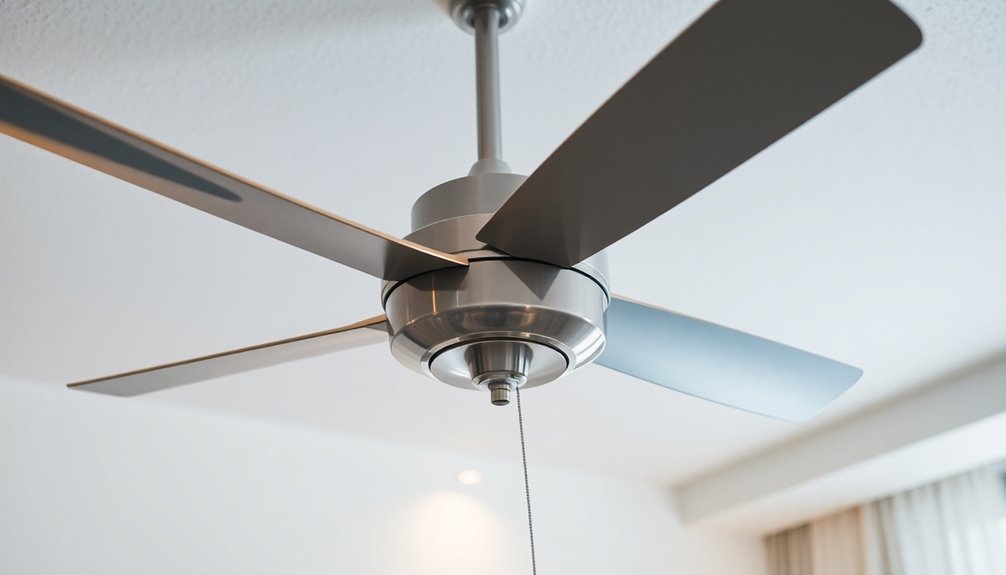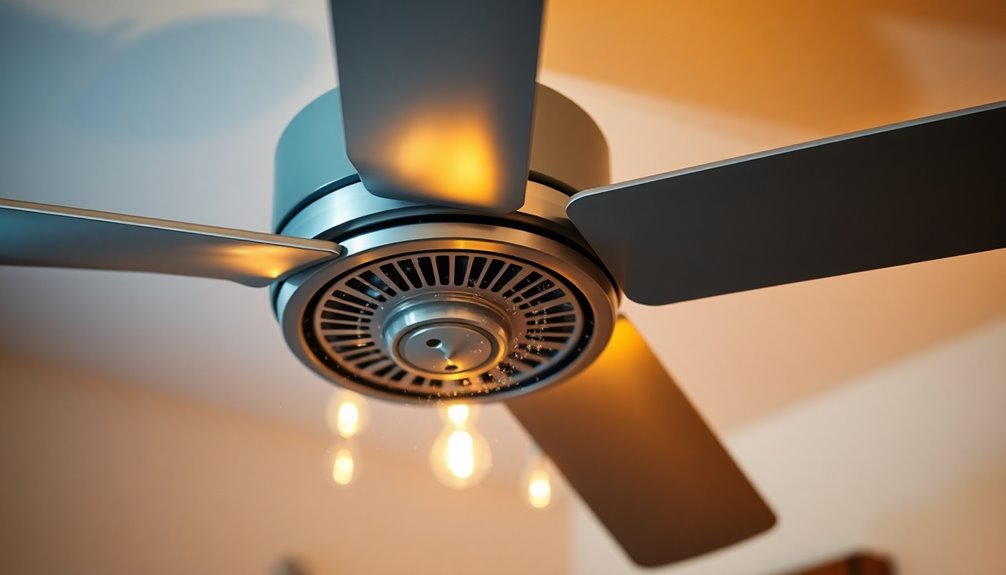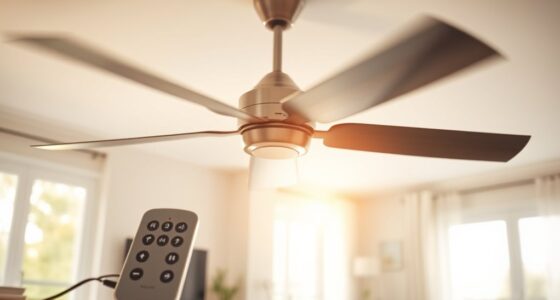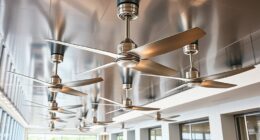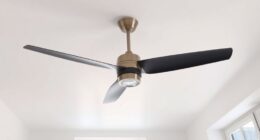A ceiling fan consists of several key parts. You'll find the motor at its core, responsible for smooth blade rotation. The blade assembly involves the blades and their attachments, essential for effective air movement. The downrod connects the motor to the ceiling, allowing for adjustable height. Don't forget the canopy, which conceals wiring and enhances appearance. Other components include capacitors that control speed and bearings for quiet operation. Each part plays an important role in the fan's performance. Discovering more about each component can help you make informed decisions for your space.
Key Takeaways
- Motor: The core component that enables smooth rotation of the fan blades, including essential elements like armature and bearings.
- Blade Assemblies: Composed of blade irons and screws, these are crucial for effective air movement and circulation.
- Downrod: An adjustable rod that connects the motor to the ceiling, allowing for customizable fan height to optimize airflow.
- Canopy: A decorative cover that conceals wiring and enhances the aesthetic appeal of the ceiling fan's design.
- Hanger Bracket: Provides stability to the fan and facilitates easy access for wiring during installation.
Major Components of Ceiling Fans

When you look at a ceiling fan, you'll notice several major components that work together to guarantee its efficient operation. The motor is the heart of the fan, consisting of essential parts like the armature, bearings, rotor, and stator. These elements enable the blades to rotate smoothly, providing the cooling effect you enjoy.
Next, you have the blade assemblies. These include blade irons, screws, and medallions that anchor the blades to the motor. Properly secured blade assemblies guarantee effective air movement, maximizing the fan's cooling capabilities. If the blades aren't attached correctly, you won't get the performance you expect.
Another important component is the downrod. This piece connects the motor to the ceiling, allowing you to adjust the fan's height for ideal airflow based on your ceiling's level. A well-chosen downrod can enhance both functionality and aesthetics, making your ceiling fan more effective in cooling your space. High-end brands often provide various downrod lengths to suit different ceiling heights.
Finally, while not the focus here, the canopy also plays a role in concealing wiring, adding a touch of style to your fan.
Understanding these major components helps you appreciate how your ceiling fan operates effectively.
Internal Parts and Functions

Ceiling fans contain several internal parts that play essential roles in their operation. Understanding these components helps you appreciate how your fan works effectively to keep your space comfortable.
- Motor: The heart of the fan, it consists of the armature, bearings, windings, rotor, stator, and shaft, all working together to enable smooth blade rotation.
- Bearings: These self-lubricated parts within the motor guarantee a quiet and seamless rotation. Typically sealed and non-replaceable, they require minimal maintenance.
- Capacitors: Run and start capacitors are significant electrical components. They control the fan's speed and help initiate its operation when you flip the switch.
- Blade Assembly: This includes blade irons, screws, and medallions that securely attach the blades to the motor. A well-constructed blade assembly is essential for effective air circulation.
External Parts and Features

Understanding the internal components of a ceiling fan sets the stage for exploring its external parts and features, which greatly impact both functionality and aesthetics.
The canopy is the decorative cover that hides the wiring between the ceiling and fan, giving your installation a clean, polished look. It's the first thing you notice when you look up at your fan.
Next, the downrod connects the fan motor to the ceiling bracket. It's adjustable in length, allowing you to customize the fan's height based on your ceiling's elevation. This is essential for ideal air circulation, guaranteeing you get the best performance from your fan.
The hanger bracket plays an important role in securely supporting the fan. It connects the fan to the ceiling, providing stability while making wiring access easy during installation or maintenance.
Lastly, while not always highlighted, the bottom cover adds an extra touch of elegance. It might feature ventilation slots to aid airflow, enhancing cooling efficiency. Additionally, the design of these external parts can influence the fan's overall aesthetics and efficiency, making it crucial to choose the right model for your space.
These external parts not only guarantee functionality but also contribute considerably to the overall look of your ceiling fan.
Performance Metrics Explained

Evaluating a ceiling fan's performance metrics is essential for making an informed choice that suits your needs. Understanding these metrics can greatly enhance your comfort and energy efficiency.
Here are some key factors to examine:
- CFM (Cubic Feet per Minute): This metric measures how much air the fan moves. Energy Star recommends a minimum of 75 CFM for energy efficiency.
- RPM (Rotations Per Minute): The RPM indicates how fast the blades spin. Higher RPM means better air movement and improved cooling efficiency.
- Amps: This measures the electric current drawn by the fan. Typically, fans without light kits use about 1 AMP, while those with additional lighting features might use up to 2 AMPS.
- Blade Pitch: The angle of the fan blades impacts airflow efficiency. A pitch between 10-15 degrees is ideal for maximizing air circulation.
Installation and Maintenance Tips

Choosing the right ceiling fan isn't just about performance metrics; proper installation and maintenance play a significant role in guaranteeing your fan operates effectively. Start by familiarizing yourself with all ceiling fan parts, including the motor, downrod, canopy, and mounting bracket. This knowledge will help make your ceiling fan installation smoother. Additionally, selecting the correct downrod length is crucial for optimal function.
Always consult the owner's manual for specific installation instructions and safety guidelines tailored to your fan model. Following these steps will make sure everything is set up correctly and safely.
Once installed, maintenance becomes vital. Regularly clean the fan blades and internal components to prevent dust buildup that can hinder performance and efficiency. Additionally, be aware that a clicking ceiling fan may indicate mechanical failure, which can pose safety risks if not addressed.
Don't forget to lubricate the motor and moving parts during maintenance to promote quiet operation and prolong the lifespan of your fan. Checking electrical wiring and connections periodically is also essential for safety and peak functionality. Increased fan efficiency can lead to lower energy bills, enhancing both comfort and savings in your home.
If you encounter complex repairs, consider hiring a professional to handle it. By taking these steps, you'll enjoy a well-functioning ceiling fan for years to come, enhancing your comfort and home ambiance.
Accessories and Decorative Elements

Accessories and decorative elements can transform a ceiling fan from a simple appliance into a stylish focal point in your room. By selecting the right components, you can enhance both functionality and aesthetic appeal.
Here are some key accessories to take into account:
- Light Fixture (Light Kit): This component not only illuminates the space but also comes in various styles like uplights or bowl kits, allowing you to match it with your décor.
- Fandangle: A fun decorative attachment for pull chains, it adds a personal touch and visual interest to your ceiling fan's design.
- Finial Nut: This decorative yet functional piece secures the glassware and finial cover in place, enhancing the overall look of the fan housing.
- Balancing Kit: Essential for stabilizing wobbling blades, this kit guarantees your fan operates smoothly and quietly, which is vital for comfort.
Incorporating these elements can elevate your ceiling fan, making it not just a functional item but also a beautiful addition to your home.
Frequently Asked Questions
What Are the Parts of the Fan Called?
When you look at a fan, you'll notice several key parts that make it work effectively.
There's the motor that powers the fan and the blade assembly that moves the air.
You've got bearings that help everything run smoothly, plus the canopy that hides the wiring.
The downrod connects the motor to the ceiling, while the hanger bracket keeps the fan secure.
Each part plays an essential role in your fan's performance.
What Is the Middle Part of a Ceiling Fan Called?
When you're looking at a ceiling fan, the middle part is called the motor. It powers the fan, making the blades rotate.
Inside the motor, you'll find components like the armature and bearings, which help it run smoothly and quietly. The motor's performance is crucial for how efficiently your fan operates.
How to Fix a Broken Ceiling Fan Blade?
When you find yourself staring at a broken ceiling fan blade, it's a coincidence that you've got the tools to fix it.
First, turn off the fan and disconnect the power. Inspect the blade for damage—can you glue it, or does it need replacing?
If you're replacing it, order a compatible blade. After securing the new one, use a balancing kit to guarantee everything runs smoothly.
Tighten all screws to avoid future wobbles.
What Is the Breakdown of a Ceiling Fan?
When you break down a ceiling fan, you'll find key components that work together.
The motor powers the fan, while the blade assembly creates airflow. The downrod connects the fan to the ceiling, and the canopy hides all the mounting hardware.
Don't forget about the receiver for remote controls and capacitors that help regulate the speed. Each part plays an essential role in ensuring your fan operates efficiently and effectively.
Conclusion
In the world of ceiling fans, each part plays a crucial role, like a well-rehearsed orchestra creating a symphony of comfort. You've explored the components that keep your space cool and stylish, from blades to motors. Now, as you enjoy the gentle breeze, remember the intricate dance happening above you. With a little care and attention, your ceiling fan can continue to perform beautifully, making every room a haven of relaxation and charm.
